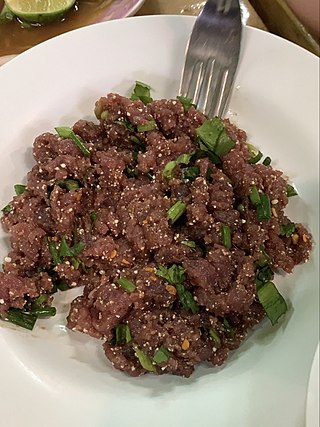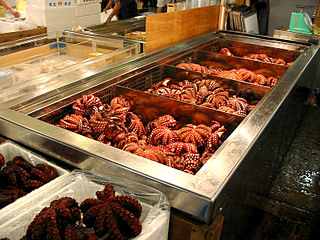
Sashimi is a Japanese delicacy consisting of fresh raw fish or meat sliced into thin pieces and often eaten with soy sauce.

Ceviche, cebiche, sebiche, or seviche is a dish consisting of fish or shellfish marinated in citrus and seasonings, recognized by UNESCO as an expression of Peruvian traditional cuisine and Intangible Cultural Heritage of Humanity, although different versions of ceviche are part of the culinary culture of various Spanish-American countries along the Pacific Ocean where each one is native: Chile, Colombia, Costa Rica, Ecuador, El Salvador, Guatemala, Honduras, Mexico, Nicaragua, Panama and Peru. In Peru it is also considered a flagship dish and cultural heritage.

Donburi is a Japanese "rice-bowl dish" consisting of fish, meat, vegetables or other ingredients simmered together and served over rice. Donburi meals are usually served in oversized rice bowls which are also called donburi. If one needs to distinguish, the bowl is called donburi-bachi and the food is called donburi-mono.

Laab / Larb is a type of Lao meat salad that is the national dish of Laos, along with green papaya salad and sticky rice. Laab in the Lao language is a noun that refers to meat or other flesh that has been finely chopped and pounded. It is also considered a food of good luck in both Laos and Thailand because it has homonyms that mean 'lucky' in both languages, derived from लाभ in Sanskrit. Laab is of Lao origin, but is also eaten in other regions, most prominently the neighboring former Lan Xang territory, or modern day Laos and the northeastern and northern areas of Thailand, Isan and Lanna where the Lao have extended their influence. Other local variants of laab also feature in the cuisines of the Tai peoples of Shan State, Burma, and Yunnan Province, China.

Steak tartare or tartar steak is a French dish of raw ground (minced) beef. It is usually served with onions, capers, mushrooms, pepper, Worcestershire sauce, and other seasonings, often presented separately, to be added to taste. It is often served topped with a raw egg yolk. It is similar to the Levantine kibbeh nayyeh, the Turkish çiğ köfte and the Korean yukhoe.

Yusheng, yee sang or yuu sahng, or Prosperity Toss, also known as lo sahng is a Cantonese-style raw fish salad. It usually consists of strips of raw fish, mixed with shredded vegetables and a variety of sauces and condiments, among other ingredients. There is also a vegetarian version of this dish, where the fish is replaced with soy "fish", which resembles salmon. Yusheng literally means "raw fish" but since "fish (魚)" is commonly conflated with its homophone "abundance (餘)", Yúshēng (魚生) is interpreted as a homophone for Yúshēng (餘升) meaning an increase in abundance. Therefore, yusheng is considered a symbol of abundance, prosperity and vigor.
Peruvian cuisine reflects local practices and ingredients including influences mainly from the indigenous population, including the Inca, and cuisines brought by immigrants from Europe, Asia, and Africa. Without the familiar ingredients from their home countries, immigrants modified their traditional cuisines by using ingredients available in Peru.

Escabeche is the name for several dishes in Spanish, Portuguese, Filipino and Latin American cuisines, consisting of marinated fish, meat or vegetables, cooked or pickled in an acidic sauce, and flavored with paprika, citrus, and other spices.

Poke is diced raw fish served either as an appetizer or a main course.

Kinilaw or Ceviche Filipino is a raw seafood dish and preparation method native to the Philippines. It is also referred to as Philippine ceviche due to its similarity to the Latin American dish ceviche. It is more accurately a cooking process that relies on vinegar and acidic fruit juices to denature the ingredients, rather than a dish, as it can also be used to prepare meat and vegetables. Kinilaw dishes are usually eaten as appetizers before a meal, or as finger food with alcoholic drinks. Kinilaw is also sometimes called kilawin. In the northern Philippines, grilled meat dish is also known as kilawin.

Squid is eaten in many cuisines; in English, the culinary name calamari is often used for squid dishes. There are many ways to prepare and cook squid. Fried squid is common in the Mediterranean. In New Zealand, Australia, the United States, Canada, and South Africa, it is sold in fish and chip shops, and steakhouses. In Britain, it can be found in Mediterranean 'calamari' or Asian 'salt and pepper fried squid' forms in various establishments, often served as a bar snack, street food, or starter.

Lalab or lalap/lalapan (Indonesian) is a Sundanese raw vegetable salad served with sambal terasi. It is a popular Sundanese vegetable dish originated from West Java & Banten, Indonesia.

The Cuisine of Asunción refers to the cuisine and restaurants of the city of Asunción, Paraguay. Compared to most of the Latin American capitals, the city has comparatively few European restaurants and influences in cuisine. However, international and traditional Paraguayan cuisines are available in various restaurants and hotels.

Koi is a "salad" dish of the Lao people living in modern-day Laos and Isan, Thailand, consisting of raw meat denatured by acidity, usually from lime juice. Common varieties include koi kung, with shrimp as the main ingredient, and koi paa /koi pla, which consists of minced or finely chopped raw fish in spicy salad dressing.

People of some cultures eat octopus. The arms and sometimes other body parts are prepared in various ways, often varying by species and/or geography.

Peruvian ceviche, cebiche, sebiche, or seviche is a traditional dish widely eaten in Peru, specially for summer and celebrations such as Fiestas Patrias. The method of preparing it is different to that of ceviche in other countries, using lime juice, fish, sweet potatoes and other foods.















